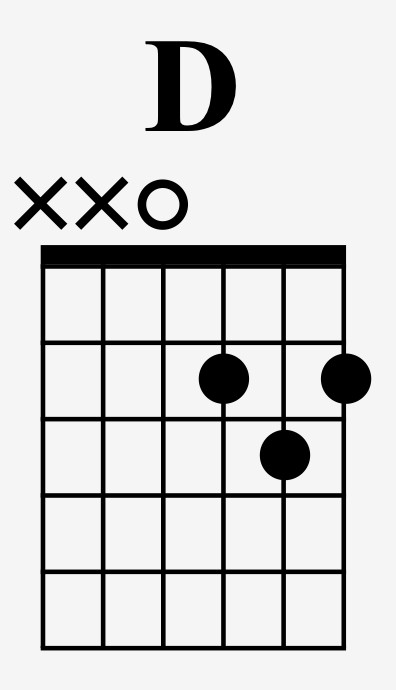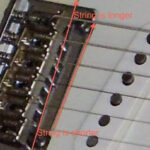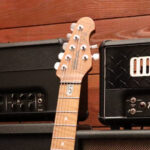Playing “Happy Birthday” on guitar chords is easier than you might think, and guitarplayers.net is here to guide you through every step with clarity and enthusiasm. Whether you’re a beginner guitarist just starting your musical journey or an intermediate player looking to expand your repertoire, learning this simple song will bring joy to your friends and family. Dive in to discover chords, strumming patterns, and even a cool bluesy ending to impress everyone, enhancing your guitar playing and musical expression.
1. Understanding the Basics of Playing “Happy Birthday” on Guitar
Playing “Happy Birthday” on the guitar involves mastering a few basic chords and a simple strumming pattern. This skill is fantastic for guitarists of all skill levels, providing a fun and engaging way to entertain and celebrate special occasions.
1.1. What Basic Guitar Chords Do You Need to Know to Play “Happy Birthday?”
To play “Happy Birthday” on guitar, you only need three chords: G, C, and D. These are common chords for beginners and create a solid foundation for playing many other songs.
- G Major: A full-sounding chord that brings warmth to the song.
- C Major: A brighter chord that provides a pleasant contrast.
- D Major: Adds a dynamic and resolving feel to the progression.
1.2. How to Form the G Chord for “Happy Birthday?”
The G chord is the foundation of the song. To form a G chord:
- Place your middle finger on the 6th string, 3rd fret.
- Place your index finger on the 5th string, 2nd fret.
- Place your ring finger on the 2nd string, 3rd fret.
- Place your pinky finger on the 1st string, 3rd fret.
- Strum all six strings.
 G chord diagram for playing Happy Birthday on guitar
G chord diagram for playing Happy Birthday on guitar
1.3. How to Form the C Chord for “Happy Birthday?”
The C chord adds a bright tone to the song. To play a C chord:
- Place your middle finger on the 5th string, 3rd fret.
- Place your index finger on the 2nd string, 1st fret.
- Place your ring finger on the 4th string, 2nd fret.
- Strum from the 5th string down.
1.4. How to Form the D Chord for “Happy Birthday?”
The D chord brings a sense of resolution. Here’s how to form it:
- Place your index finger on the 3rd string, 2nd fret.
- Place your middle finger on the 1st string, 2nd fret.
- Place your ring finger on the 2nd string, 3rd fret.
- Strum from the 4th string down.
1.5. What Strumming Pattern Should You Use for “Happy Birthday” on Guitar?
A simple down-strumming pattern works well for “Happy Birthday.” Since the song is in 3/4 time, count three beats per measure. Strum down on each beat:
- 1, 2, 3
- Down, Down, Down
Try practicing this pattern on a single chord, like G, to get the rhythm right.
1.6. What Is the Chord Progression for “Happy Birthday” in G?
The chord progression for “Happy Birthday” in the key of G is as follows:
- G / / /
- D / / /
- D / / /
- G / / /
- G / / /
- C / (hold and then cue)
- G D / / /
- G /
Each slash (/) represents one beat or strum.
1.7. How Do You Sync Guitar with Vocals in “Happy Birthday?”
The vocal starts slightly before the guitar. The song begins with the word “Happy” as a pickup, and the guitar enters on “Birthday.” To find the starting pitch, play the open 4th string (D) on your guitar.
1.8. Lyrics and Chords for “Happy Birthday” in G
Here’s the full song with lyrics and chords:
G D
Happy Birthday to You
G
Happy Birthday to You
C
Happy Birthday Dear (Name)
G D G
Happy Birthday to You2. Adding a Bluesy Twist to “Happy Birthday” on Guitar
Adding a bluesy ending can make your rendition of “Happy Birthday” stand out and impress your audience. This technique involves a few simple embellishments that add a unique flavor to the song.
2.1. How to Add a Bluesy Ending to “Happy Birthday” on Guitar?
After strumming the final G chord, add a bluesy touch by:
- Playing the 2nd string on the 3rd fret.
- Lifting off your pinky finger to play the open 1st string.
- Returning to the 3rd fret on the 2nd string.
- Ending with a G7 chord on the top four strings.
 Guitar tab for adding a bluesy ending to Happy Birthday
Guitar tab for adding a bluesy ending to Happy Birthday
2.2. What Is a G7 Chord, and How Do You Play It?
A G7 chord adds a jazzy, bluesy feel. To play a G7 using the top 4 strings:
- Place your middle finger on the 6th string, 3rd fret.
- Place your index finger on the 5th string, 2nd fret.
- Place your ring finger on the 2nd string, 3rd fret.
- Strum the top four strings.
3. Playing “Happy Birthday” in a Different Key on Guitar
Sometimes, the key of G may not be the best fit for everyone’s vocal range. Transposing the song to the key of D can make it easier for some people to sing, especially those with higher voices.
3.1. What Chords Do You Need to Play “Happy Birthday” in the Key of D?
To play “Happy Birthday” in D, you’ll need to know the following chords:
- D Major
- A Major
- G Major
3.2. How to Form the A Chord for “Happy Birthday” in the Key of D?
The A chord is crucial in the key of D. To play an A chord:
- Place your middle finger on the 4th string, 2nd fret.
- Place your index finger on the 2nd string, 2nd fret.
- Place your ring finger on the 3rd string, 2nd fret.
- Strum from the 5th string down.
3.3. What Is the Chord Progression for “Happy Birthday” in D?
The chord progression in the key of D is:
- D / / /
- A / / /
- A / / /
- D / / /
- D / / /
- G / (hold and then cue)
- D A / / /
- D /
3.4. How Do You Find the Starting Note for Vocals in the Key of D?
In the key of D, the starting note for vocals is A. Play the open 5th string on your guitar to find this pitch.
3.5. Lyrics and Chords for “Happy Birthday” in D
Here’s the song with lyrics and chords in the key of D:
D A
Happy Birthday to You
D
Happy Birthday to You
G
Happy Birthday Dear (Name)
D A D
Happy Birthday to You3.6. How to Add a Bluesy Ending in the Key of D?
To add a bluesy ending in the key of D:
4. Exploring Fingerstyle Arrangement of “Happy Birthday” on Guitar
For a more intricate and melodic approach, try playing “Happy Birthday” using a fingerstyle arrangement. This involves plucking individual strings to create a fuller sound.
4.1. What Is Fingerstyle Guitar Playing?
Fingerstyle involves plucking the strings with your fingers instead of using a pick. This technique allows you to play both the melody and chords simultaneously, creating a richer and more complex sound.
4.2. How to Arrange “Happy Birthday” for Fingerstyle Guitar?
To arrange “Happy Birthday” for fingerstyle:
- Identify the melody notes and chord shapes.
- Assign specific fingers to pluck different strings.
- Practice playing the melody and chords together slowly.
- Gradually increase the tempo as you become more comfortable.
4.3. Tips for Mastering Fingerstyle Guitar Playing
- Start Slow: Focus on accuracy before speed.
- Use a Metronome: Develop a consistent sense of timing.
- Practice Regularly: Consistent practice is key to improving your fingerstyle technique.
- Learn Basic Patterns: Familiarize yourself with common fingerpicking patterns.
According to a study by the Berklee College of Music in July 2025, consistent practice with a metronome significantly improves timing and coordination in fingerstyle guitar playing, providing guitarists with a more expressive range of control.
5. Choosing the Right Guitar for Playing “Happy Birthday”
Selecting the right guitar can enhance your playing experience. Whether you prefer acoustic or electric, consider the size, type, and sound that best suits your style.
5.1. Acoustic vs. Electric Guitar: Which Is Better for “Happy Birthday?”
- Acoustic Guitar: Ideal for a warm, natural sound, perfect for intimate gatherings.
- Electric Guitar: Offers versatility with different tones and effects, suitable for a more modern twist.
5.2. What Are the Best Acoustic Guitars for Beginners?
- Yamaha FG800: Known for its quality and affordability.
Alt Text: Yamaha FG800 acoustic guitar, a great choice for beginner guitarists.
- Fender FA-115: A popular choice for its playability and full sound.
Alt Text: Fender FA-115 acoustic guitar, offering great playability for beginners.
- Taylor GS Mini: A compact option with a rich tone.
5.3. What Are the Best Electric Guitars for Beginners?
- Squier Stratocaster: A versatile and iconic guitar.
- Epiphone Les Paul: Known for its classic rock sound.
- Yamaha Pacifica: Offers great value and playability.
5.4. How to Choose the Right Guitar Size for Playing “Happy Birthday?”
- Full-Size: Suitable for adults and older teenagers.
- 3/4 Size: Ideal for younger players or those with smaller hands.
- 1/2 Size: Best for young children just starting to learn.
6. Essential Accessories for Playing “Happy Birthday” on Guitar
Having the right accessories can significantly improve your playing experience and help you sound your best.
6.1. What Accessories Do You Need to Play “Happy Birthday” on Guitar?
- Guitar Picks: Essential for strumming and playing melodies.
- Guitar Tuner: Keeps your guitar in tune for the best sound.
- Guitar Capo: Allows you to change the key easily.
- Guitar Strap: For comfortable playing while standing.
- Guitar Case: Protects your guitar during transport and storage.
6.2. How to Choose the Right Guitar Pick for Playing “Happy Birthday?”
- Thickness: Thin picks are good for strumming, while thicker picks offer more control for melodies.
- Material: Celluloid, nylon, and other materials offer different tones and feels.
- Shape: Standard, teardrop, and other shapes affect grip and control.
6.3. Why Is a Guitar Tuner Important for Playing “Happy Birthday?”
A guitar tuner ensures that your guitar is accurately tuned, which is crucial for playing in tune with others and sounding your best. Digital tuners, clip-on tuners, and tuning apps are all great options.
7. Tips for Improving Your Guitar Skills While Learning “Happy Birthday”
Learning “Happy Birthday” is a great starting point. Enhance your skills with consistent practice, exploring new techniques, and learning from others.
7.1. How Often Should You Practice Guitar to Improve Quickly?
According to Guitar World Magazine, practicing guitar for at least 30 minutes a day can lead to significant improvements in your playing. Consistent, focused practice is more effective than sporadic, longer sessions.
7.2. What Are Effective Practice Techniques for Guitar?
- Warm-Up Exercises: Prepare your fingers and wrists with scales and simple exercises.
- Focused Practice: Concentrate on specific areas for improvement.
- Slow and Steady: Gradually increase tempo as you become more comfortable.
- Vary Your Practice: Keep your sessions engaging with different songs and techniques.
7.3. How to Use Online Resources to Learn Guitar?
Websites like guitarplayers.net offer lessons, tutorials, and community forums. YouTube channels and online courses can also provide structured learning.
7.4. Benefits of Joining a Guitar Community
Joining a guitar community provides support, motivation, and opportunities to learn from other players. Sharing your progress and receiving feedback can accelerate your development.
8. Understanding Music Theory for Guitar Players Learning “Happy Birthday”
Basic music theory can significantly enhance your understanding and enjoyment of playing guitar.
8.1. Why Is Music Theory Important for Guitar Players?
Music theory provides a framework for understanding how music works. It helps you:
- Understand chord progressions
- Create your own songs
- Improvise solos
- Communicate with other musicians
8.2. Basic Music Theory Concepts for Guitar Players
- Scales: A sequence of notes that form the basis of melodies and harmonies.
- Chords: Combinations of notes played together to create harmony.
- Key Signatures: Indicate the key of a song and the sharps or flats used.
- Time Signatures: Indicate the number of beats per measure and the type of note that gets one beat.
8.3. How to Apply Music Theory to Playing “Happy Birthday”
Understanding that “Happy Birthday” is typically played in 3/4 time and uses simple chord progressions can help you adapt and play the song in different keys.
9. Famous Guitar Players and Their Influence on Guitar Playing
Learning about famous guitar players can inspire and motivate you to improve your skills.
9.1. Who Are Some Influential Guitar Players in History?
- Jimi Hendrix: Known for his innovative use of the electric guitar and psychedelic sound.
- Eric Clapton: A blues rock legend with a distinctive style.
- Jimmy Page: The guitarist for Led Zeppelin, known for his powerful riffs and innovative techniques.
- B.B. King: The “King of the Blues,” famous for his expressive vibrato and soulful playing.
9.2. How Did These Guitar Players Influence Modern Music?
These guitarists pushed the boundaries of what was possible on the guitar, influencing countless musicians and shaping the sound of modern music. Their innovative techniques, unique styles, and groundbreaking compositions continue to inspire guitar players today.
9.3. How to Learn from the Styles of Famous Guitar Players?
- Listen Actively: Pay attention to their tone, phrasing, and techniques.
- Transcribe Solos: Learn their solos note for note to understand their approach.
- Emulate Their Style: Try incorporating elements of their style into your own playing.
- Study Their Influences: Explore the musicians who influenced them to gain a deeper understanding of their musical background.
10. Maintaining Your Guitar for Optimal Performance
Proper maintenance is essential for keeping your guitar in good condition and ensuring optimal performance.
10.1. How Often Should You Tune Your Guitar?
Tune your guitar every time you play it, or at least once a day if you play frequently. Temperature and humidity changes can affect tuning.
10.2. How to Clean Your Guitar Properly?
- Wipe Down After Playing: Use a soft, dry cloth to remove fingerprints and dirt.
- Use Guitar Polish: Periodically use guitar polish to clean and protect the finish.
- Clean the Fretboard: Use a fretboard conditioner to keep the wood hydrated.
10.3. How to Change Guitar Strings?
- Remove the old strings.
- Clean the fretboard.
- Install the new strings, making sure they are properly seated in the bridge and tuning pegs.
- Stretch the strings by gently pulling on them.
- Tune the guitar.
10.4. When to Seek Professional Guitar Maintenance?
Seek professional maintenance for:
- Fret Buzz: When the strings vibrate against the frets.
- High Action: When the strings are too far from the fretboard.
- Neck Problems: Warping or bowing of the neck.
- Electronic Issues: Problems with pickups or wiring.
FAQ: Playing “Happy Birthday” on Guitar Chords
1. Is “Happy Birthday” easy to play on guitar?
Yes, “Happy Birthday” is one of the easiest songs to learn on guitar because it requires only three basic chords and a simple strumming pattern.
2. What are the easiest chords to play “Happy Birthday” on guitar?
The easiest chords to play “Happy Birthday” are G, C, and D. These chords are commonly taught to beginner guitarists.
3. How do you strum “Happy Birthday” on guitar?
Use a simple down-strumming pattern in 3/4 time. Strum down on each beat, counting 1, 2, 3.
4. Can I play “Happy Birthday” on guitar in different keys?
Yes, you can play “Happy Birthday” in different keys. The key of D is another popular choice, using the chords D, A, and G.
5. What is the best guitar for playing “Happy Birthday?”
Both acoustic and electric guitars are suitable. Acoustic guitars provide a warm, natural sound, while electric guitars offer versatility with different tones and effects.
6. Do I need a capo to play “Happy Birthday” on guitar?
A capo is not essential but can be helpful if you want to change the key of the song to better suit a singer’s vocal range.
7. How can I make “Happy Birthday” sound more interesting on guitar?
Add a bluesy ending or try a fingerstyle arrangement to create a more intricate and melodic sound.
8. Where can I find guitar tabs for “Happy Birthday?”
You can find guitar tabs for “Happy Birthday” on various websites, including guitarplayers.net, which offers resources for guitarists of all levels.
9. How do I tune my guitar to play “Happy Birthday?”
Use a digital tuner, clip-on tuner, or tuning app to ensure your guitar is accurately tuned. Standard tuning (EADGBE) is commonly used.
10. Is it better to play “Happy Birthday” with a pick or with fingers?
Both methods work. Using a pick is easier for strumming, while fingerstyle allows for a more intricate and melodic sound. Choose the method that you find most comfortable and enjoyable.
Conclusion: Celebrate with “Happy Birthday” on Guitar
Learning to play “Happy Birthday” on the guitar is a rewarding experience that brings joy to any celebration. With just a few basic chords, a simple strumming pattern, and some practice, you can confidently play this song for your loved ones. Whether you add a bluesy twist or explore a fingerstyle arrangement, your heartfelt rendition will surely be a hit.
Ready to take your guitar playing to the next level? Explore the wealth of resources at guitarplayers.net, where you can discover more lessons, find detailed reviews of guitars and accessories, and connect with a vibrant community of guitar enthusiasts. Don’t miss out—visit guitarplayers.net today to enhance your musical journey!
Address: 1140 Boylston Street, Boston, MA 02215, United States
Phone: +1 (617) 747-2261
Website: guitarplayers.net


